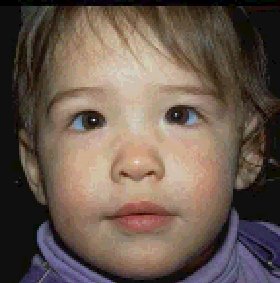< Page 5 of 12 >
1 2 3 4 5 6 7 8 9 10 11 12
More on Strabismus
Strabismus (misaligned eyes).
Amblyopia
occurs most commonly with misaligned or crossed eyes which is known
as strabismus. The crossed eye �turns off� to avoid double vision and
the child uses only the better eye. The eye that is not being used can
eventually lose its ablity to function and loss of vision can become
permanent.
Accommodative
esotropia
Accommodative esotropia occurs when there is a significant amount of
hyperopia in a young child. A child�s crystalline lens is very flexible.
So even though a significant amount of hyperopia may be present, through
accommodation, the child can still produce enough plus power to bring
the light to focus on the retina. Normally, accommodation occurs to
focus objects for near vision tasks. However, when a child is farsighted,
or hyperopic, the lens must be used constantly. Associated with accommodation,
is convergence. The more we accommodate, the more the eyes tend to converge.
When there is a significant amount of accommodation manifest in a young
child, the eyes will tend to turn in or �cross� creating a condition
called esotropia. When the eyes cross, the brain cannot fuse the two
images it receives into one, therefore the child sees two images, suffering
from double vision or diplopia. Since seeing two images is an intolerable
condition, the child suppresses vision in one of the eyes. When vision
is suppressed the eye can lose its ability to function, thus becoming
amblyopic.The figure on the bottom of page 11 shows and infant with
accommodative esotropia with and without corrective lenses. Notice how
the eyes become properly aligned when the lenses are in place.
Plus powered spectacle lenses can be used to treat accommodative esotropia. By placing a plus powered lens in front of the eye, all or part of the hyperopia is corrected, minimizing the necessity for the child to accommodate in order to bring vision into focus. This resolves the problem of overconvergence as long as the lenses are in place. When the lenses are removed, the eyes may cross again.
Contact lenses can also work as well as glasses in the treatment of accommodative esotropia. However they are generally more expensive and demand more attention. Adolescents, are often willing to undertake the responsibility for handling the contact lenses. Other treatments may involve surgery to correct the unbalanced eye muscles or to remove a cataract. Covering or patching the strong eye to improve amblyopia is often necessary.
Esotropia
Esotropia, is not necessarily accommodative. It can occur when there
is an imbalance in the tension of the extraocular muscles which cause
the eye to move in all directions and is the most common type of strabismus
in infants. In most cases, early surgery can align the eyes. During
surgery for esotropia, the tension of the eye muscles in one or both
eyes is adjusted. The tight inner muscles may be removed from the wall
of the eye and placed further back on the eye. This adjustment weakens
their pull and allows the eyes to move outward. Sometimes the outer
muscles are tightened by shortening the muscle length to allow the eyes
to move outward.
Exotropia
Exotropia, or an outward turning eye, is another common type of strabismus.
This occurs most often when a child is focusing on distant objects.
The exotropia may occur only from time to time, particularly when a
child is daydreaming, ill or tired. Parents often notice that the child
squints one eye in bright sunlight. Although glasses, exercises or prisms
may reduce or help control the outward turning eye in some children,
surgery is often needed.
Strabismus Surgery
The ophthalmologist makes a small incision in the tissue covering the
eye to reach the eye muscles. Certain muscles are repositioned during
the surgery, depending on which direction the eye is turning. It may
be necessary to perform surgery on one or both eyes. When strabismus
surgery is performed on children, a general anesthetic is required.
Local anesthesia is an option for adults.
Recovery time is rapid. People are usually able to resume their normal activities within a few days. After surgery, glasses or prisms may be useful. In many cases, further surgery may be needed at a later stage to keep the eyes straight.
For children with constant strabismus, early surgery offers the best chance for the eyes to work well together. In general, it is easier for children to undergo such surgery before school age. As with any surgery, eye muscle surgery has certain risks. These include infection, bleeding, excessive scarring and other rare complications that can lead to loss of vison. Strabismuy surgery is usually a safe and effective treatment for eye misalingment. It is not, however a substistute for glasses or amblyopia therapy.

< Page 5 of 12 >
1 2 3 4 5 6 7 8 9 10 11 12